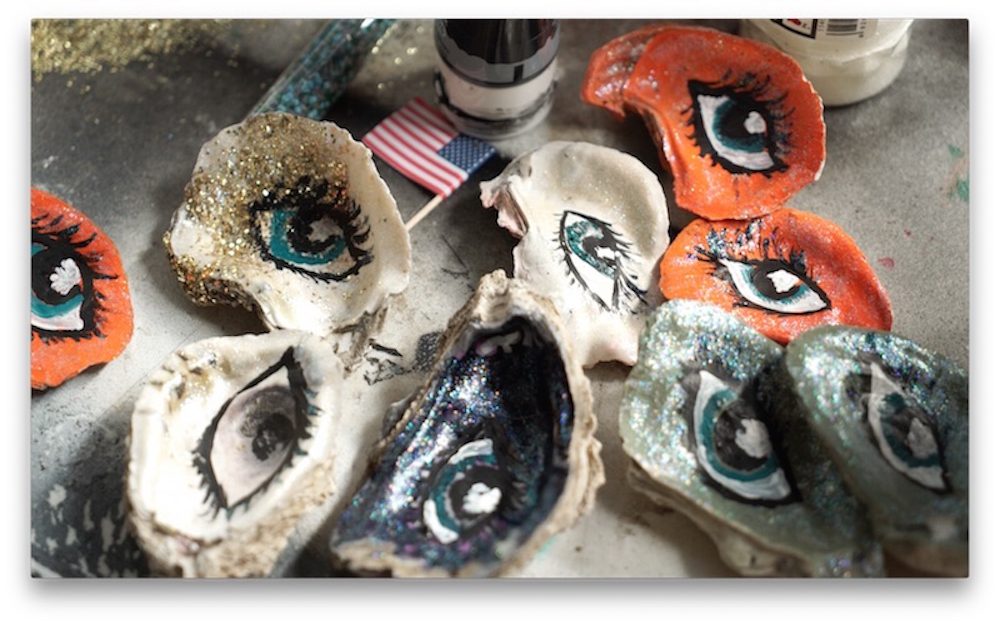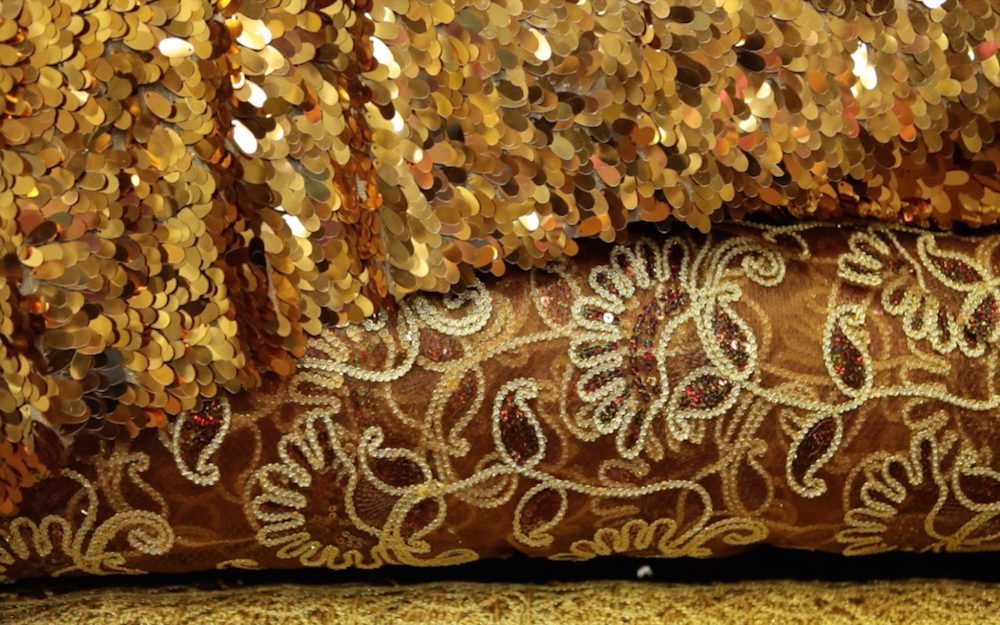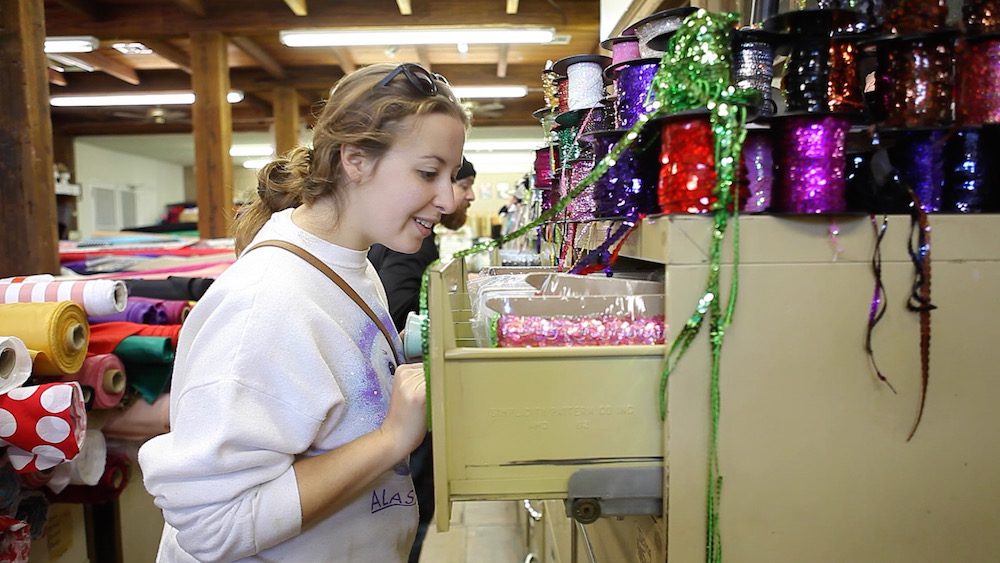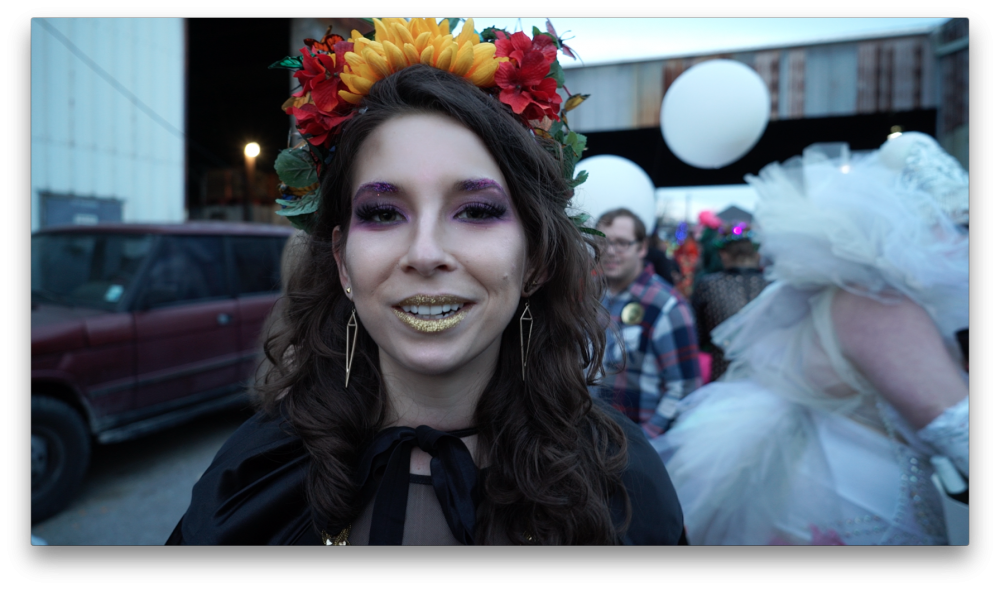The Exceptionally Extraordinary Emporium: An Interview with Lindsey Phillips
Taylor Murrow interviews filmmaker Lindsey Phillips on the making of her short documentary film.

Production still of painted oyster shells for the Bearded Oysters. Courtesy Lindsey Phillips.
Editor's Note
It’s that time of year in New Orleans, when the revelers of Carnival season are putting the finishing touches on their costumes. Filmmaker Lindsey Phillips has been busy as well, working on her first short documentary film: The Exceptionally Extraordinary Emporium. At its center is Jefferson Variety Stores, a family-owned bazaar of colorful fabrics, fringe, sequins, feathers, glitter, appliqués, and more that many locals consider a haven for homegrown costuming. Pelican Bomb’s Taylor Murrow recently spoke with Phillips about the making of the film and how a girl from Ohio fell in love with New Orleans’ varied costuming traditions.
Taylor Murrow: Tell me a little bit about your background as a filmmaker.
Lindsey Phillips: In high school, all I really wanted to do was run around and make funny movies. I grew up in middle-of-nowhere Ohio and then studied Digital Media Production at the Art Institute of Pittsburgh. I lived and worked in Pittsburgh for a while and I just needed a change. I knew someone who had moved down to New Orleans and I heard there was a lot of filmmaking happening. I moved to New Orleans in 2010 and I’ve mostly been freelancing since then. I was an editor on Luisa Dantas’ Land of Opportunity, a documentary that has expanded into an online interactive platform. It’s about New Orleans but also addresses different cities across the country that have dealt with crisis, redevelopment, and rebuilding. I also direct Cinema Reset, which is a new media and experimental film program at the New Orleans Film Festival.
TM: So where does the costuming fit in? Did it become an interest once you moved down here?
LP: It wasn’t until recently that I realized why I was so interested. As a kid I really liked to sew, and when I was in high school I liked to make weird outfits. I wore socks on my arms. I made my own pants. I put safety pins on everything. I made a duct tape prom dress. I did it probably for the sake of being weird.
One of my favorite things about Carnival time is the amazing costumes that people make and to witness their creativity and imagination. It’s not just artistic people creating costumes. You don’t have to have any skills in crafting or art making—it’s for everybody to come together and celebrate. For a lot of people, it’s really meaningful. I’ve talked to a handful of folks whose costumes are something they’ve thought deeply about—something important that happened to them that year or maybe they’re channeling a spiritual being or goddess-like figure. Then it becomes a spiritual thing—putting this outfit on, taking on this persona, and going out into the city.
TM: That’s what I always find to be one of the most rewarding and fun aspects of costuming. If you want, you can allow yourself to completely transform for a day or however long you’re wearing the costume. How did you decide that you wanted to focus the documentary on Jefferson Variety?
LP: I was at a costume-making party one day and a friend had this very beautiful, pink scalloped fabric. The next week I was at Jefferson Variety and saw a man who had the exact same fabric. It made me wonder how many different people might have the same piece of fabric throughout the city—this literal common thread that binds them.
I talked to Lisa Tracy, the owner of the store, for an hour off camera and asked if I could come back and talk to customers while they were shopping to see what they’re making.
TM: I remember the first time I went to Jefferson Variety, probably three or four years ago. It’s this unassuming place in the middle of warehouses by the river. You could drive by it and never know it’s there.
LP: Yes! And you walk in and it’s just like [Phillips makes an explosion noise].
TM: An explosion of glitter and sequins! I’m curious why you choose to make a short-form documentary?
LP: This is the first project that I’m directing and producing on my own. So for my own sanity, I felt like I needed to make a short. It’s challenging now because I’m overwhelmed trying to fit in all of these stories. I wanted to focus on Jefferson Variety because you really only know about it if you live in New Orleans.
TM: It’s word of mouth. There are no advertisements or billboards to direct you: “OK, this is where you go to buy your costume supplies!”
LP: Exactly. I chose to focus on the store, and how important it is to New Orleans and to Mardi Gras, as a way to peek into the lives of people who costume. My big hope is that the short will eventually be a catalyst for a larger online interactive archive of some sort. I’m not quite sure how that’s going to manifest. Maybe the website will look like Jefferson Variety…You’ll click on the glitter section and there’s a bunch of short documentary clips about all the people who use glitter. You’ll go to the fringe section and there are clips of people on how they use their fringe or feathers. It could be an interesting way to continue to show the range in how people costume in this city.

Production still of sequined fabric at Jefferson Variety. Courtesy Lindsey Phillips.
TM: I really like the idea you mentioned earlier of Jefferson Variety as a common thread for New Orleanians. I’ve already been there twice in the last two weeks, and each time there is such an eclectic group of people in there. I’m always amazed to hear what they’re working on.
LP: Yeah, people surprise you. For instance, my sound guy and I saw this one man there. He’s middle aged, he’s got a hunting cap on, and he’s shopping for sparkly purple sequins. When we ask what he’s doing with them, he replies, “Oh, I’m making a ball gown for my daughter-in-law for Zulu. It’s her first year.” It’s a normal yet totally remarkable thing.
TM: When it’s all said and done people outside of the city will get a chance to see the film. As someone who’s from the Midwest, what do you think the reaction will be?
LP: I had no idea what to expect my first Mardi Gras. Like most people from other places I thought, “OK, I’m just going to see a ton of boobs. There are beads and you get the beads by showing your boobs.” I’ve been here for four and a half years and I have yet to see boobs. I know where I can see them, but I choose not to because the rest of the city is so family and community-oriented in their celebrations. That’s what excites me about Mardi Gras—costuming as a way of bringing people together.
TM: Are you working on your costume right now?
LP: I keep having ideas for things, but who knows if they’ll actually come together. I may have to pull from things I already have.
TM: You were sporting quite a few awesome costumes in your Kickstarter video.
LP: Most of those were borrowed, which is so funny because costuming is something I love and really admire. I will go to the thrift store. I’ll have an idea and I’ll pick up pieces. Then I’ll go to Jefferson Variety and get some appliqués or a bunch of trim and fringe, but most of my costumes are not as crazy and elaborate as I’d like them to be.
TM: I know what you mean. I have a similar problem where I’ll go to Jefferson Variety and not have anything solid in mind. Then I end up buying two yards of ten different styles of sequined trim, and I get home and wonder what the hell I’m going to do with it.

Production still of shopper Jenna Addis of the Krewe of Muses at Jefferson Variety. Courtesy Lindsey Phillips.
TM: How does the Jefferson Variety staff react to you being there?
LP: Oh, now that I’ve been there plenty of times, they’re all fine with it. Another thing I love about the store is that more than half of the people who work there are family. They work and live together and then spend holidays and vacations together. They spend so much time together!
TM: I wonder if they costume at all.
LP: No, they don’t. Most of them don’t even sew, which seems crazy to me.
TM: Wow. I guess if you’re around it all the time maybe it wears you out.
LP: I think they work so hard during Carnival season that by Mardi Gras Day they just want to rest. They said they do try to go to a parade if they can, but a lot of times they’ll go to someone’s house for a crawfish boil and just relax.
Have you always costumed for Mardi Gras?
TM: I’m from here. In my experience, maybe your parents will dress you up in costume when you’re really little. Then once you’re a bit older, maybe a preteen or teenager, you don’t dress up. You just go to parades to have fun and hang out. I would say I got more into it when I was in college. For me, as an adult, costuming is also very therapeutic. If I can sit there and paint on fabric or glue on rhinestones for an hour or two and maybe have some music or Netflix on in the background, it’s very calming. It serves a few purposes. I’ve definitely gotten more involved in it during my adult years.
LP: I ask because I’ve talked to some people who grew up here and many said that they didn’t really costume until their friends that moved here started costuming.
TM: That’s a good point. I would say the majority of my friends in college were from out of state. People who are new to the entire Carnival experience are amazed by it and that makes participating more thrilling and fun as a local—a costume enhances that experience.
LP: An original thought for this film that I’ve had to nix for now was this idea of following old school and new school forms of costuming. Like me, there are a ton of transplants that have moved—and are still moving here—and I wonder how that will affect costuming and Mardi Gras traditions in general. Are newcomers’ reasons for costuming parallel at all to those who have been doing it for years? It’s time to think about that.

Production still of Taylor Murrow at Krewe of Goddesses. Courtesy Lindsey Phillips.



